June 2021: Carol Brown
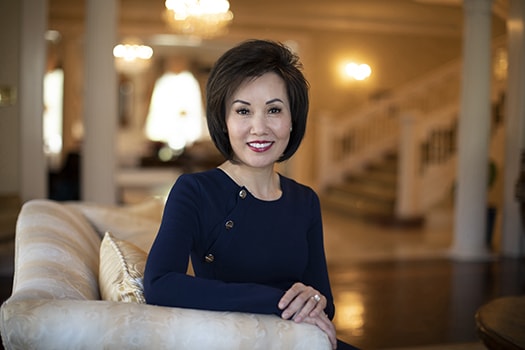
This June, our Curator’s Corner examines two spectacular ichthyosaur fossils recovered here in Nevada, that invite us to consider the enormous depth – literally and figuratively speaking – of our geological history.
Thanks to the Berlin-Ichthyosaur State Park, our Nevada State Museum in Carson City is able to preserve, document, and share these fossilized moments in history with the public. The Berlin-Ichthyosaur State Park is widely known for William Gordon Huff’s life-size bas-relief of the Shonisaurus, the ichthyosaur genus found in the region.
In 1957, the California-based sculptor proposed two 70’ artworks, one of an ichthyosaur skeleton and the other a reconstruction of a swimming ichthyosaur, to be facing each other and built as part of one long self-standing wall located just south of a quarry where the geological excavating of this same specimen was to occur. Because of the limited state budget, only one of the sculptures was able to be built – the skeleton bas-relief which we have today – and during the beginning stages of construction, Huff happened to break a rib in an accident while moving materials. He recovered, but for others like him- over the age of 50 at the time of his accident – recovery is not so easy.
Osteoporosis is a bone disease which causes bones to become brittle and susceptible to breaking easily. While it affects men and women of all races, studies show that white and Asian women are most at risk. This month, I am moved and inspired to present Carol Brown’s artistic journey that addresses her own osteoporosis.
Together as Nevadans, let us study the past, honor the present, and envision the future.
This month, it is my pleasure to present… Carol Brown!

Carol Brown
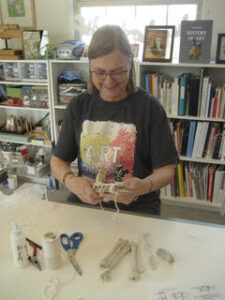
The Artist in her Carson City studio, 2020
My first art therapy project about osteoporosis focused upon a manual procedure of assembling plastic bones, covering them in handmade paper and encaustic, and then taking the skeleton apart and putting it back together in aesthetic forms. As an artist living with osteoporosis since 1996, I approach this artwork from two perspectives: a molecular viewpoint and an external viewpoint.
Bones make me think about ancient cultures, global locations, civilizations, tribes, religions, and how differently each deal with death, burial rituals and belief in the after-life. No matter where you are from, our bones are the same.
Thinking of how doctors treat broken bones inspires me to cover the bones with wax, wrap them in string, weaving and tying the string into knots, tying the embellishments onto wood. This process suggests ways we mend fractures and broken bones. I chose to work with century-old, natural, materials that reflected ancient cultures: these include linin, silk, handmade paper, suede, wax, string, and old wood.
I am sure everyone here will think of their experiences and their own health related to my art in ways I never thought about while I was creating these works. Art is a process. Life is a process. And healing is a process too.
-Carol Brown
THE ART
Carol Brown specializes in the Japanese method of multicolor woodblock printing, mokuhanga. This carefully executed discipline focuses upon a process of manually carving each colored layer of an image backwards onto a close-grained wood block utilizing an assortment of bladed tools. Once this subtractive process is completed, the blocks are applied with inks and aligned with specialty paper creating a multi-colored, limited-edition artwork. Seemingly a sculptural approach, its results are traditionally two dimensional.
This same act of creating flattened space through a time-consuming subtractive process is in effect what ossuaries do, allowing past civilizations to store skeletal remains in tight arrangements that transform our own human histories into layers of sacred architecture. Scattered deep in the earth across Europe these sites share a universality in reconfiguring the bones of past civilizations through a process of aesthetic assembly and reduction that both resurrects and brings peace to our sculptural selves.
A spiritual tension between material transformation and its own preservation is at the core of Brown’s work as an artist living with a bone degenerative disease. According to the National Osteoporosis Foundation, osteoporosis is considered a public health threat for an estimated 54 million Americans, or 50 percent of people 50 years of age and older. Ten million individuals in the U.S. are estimated to already have the disease.
Brown’s surgical precision approach to mokuhanga influences her triage assemblages. There is a sense of ceremony conveyed through her handling of these relic-like materials of wax, wood and leather. “My work continues to undergo its process of metamorphoses. My attitude toward the disease has as well. Somehow, by embracing reality through my artwork, I am able to live in more conscious acceptance of my condition, “says the artist.
(Re)constructing one’s own spiritual, mental, and physical self requires a deep inner acceptance. This formulates a courage which I believe to be the unseen binding agent in the work. It is no surprise that that the National Osteoporosis Foundation, and Duke University have featured her journey and artwork in their programming and lectures because of her unique ability to share her own history with others. Art has a way of doing that throughout time.
For more information on the artist please visit these sites:
www.mokuhanga-studio.com
www.bonetalk.org/articles/2019/4/24/acceptance-without-surrender-my-osteoporosis-story
For more information on Osteoporosis please visit:
www.nof.org/patients/what-is-osteoporosis/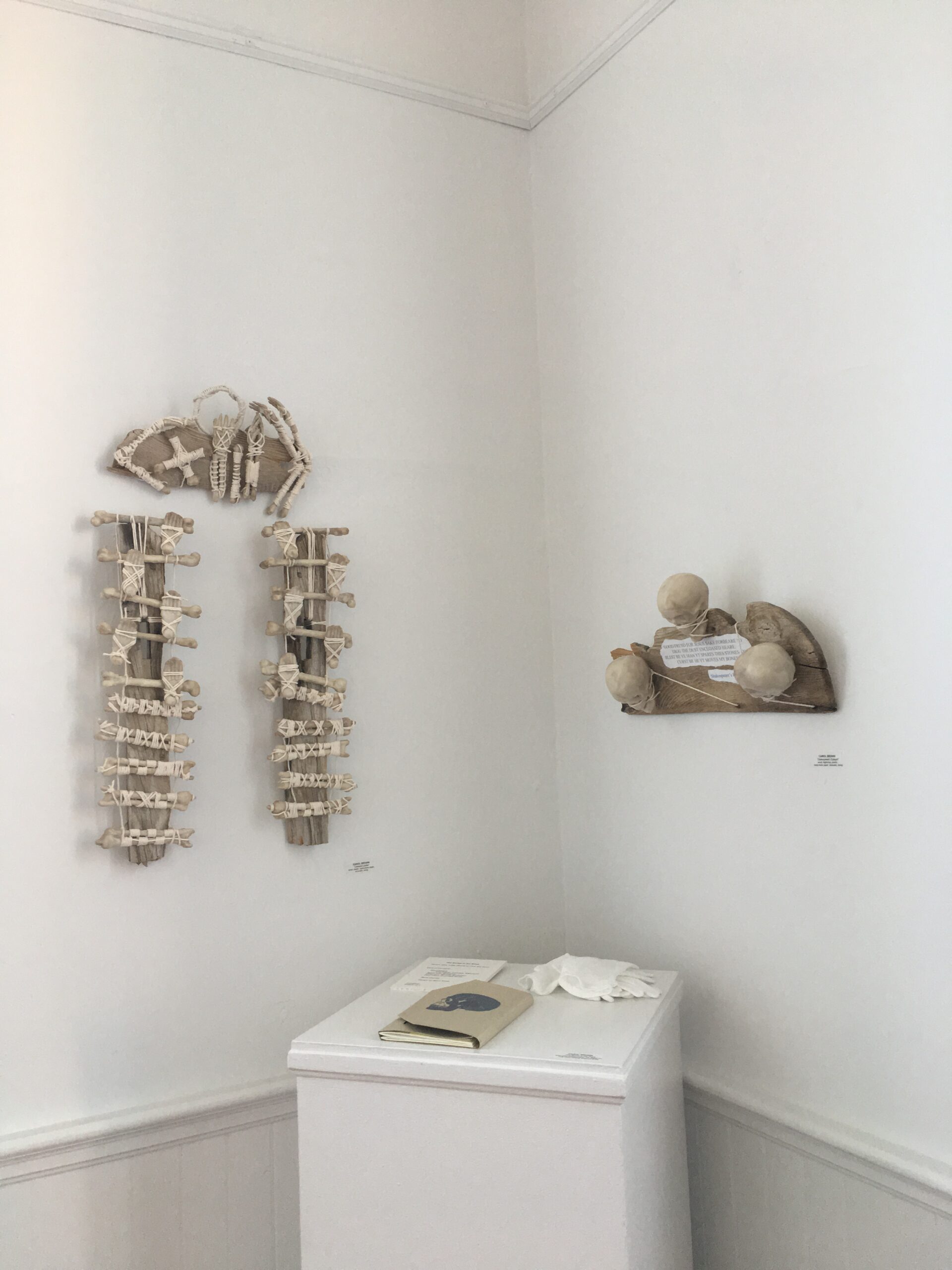
Photo: Courtesy of St. Mary’s Art Center
Left: Celestial Ladder, 2015 – 2017
Wood, plastic, handmade paper, encaustic, string
Top: 9″ x 14″ x 3″
Bottom: 24″ x 7″ x 4’
Pedestal: The Bones in the Book, 2015 – 2017
Relief prints, digital text, long-stitch binding with waxed string
Right: Shakespeare’s Epitaph, 2015 – 2017
wood, digital text, plastic, hand made paper, encaustic, string
20″ x 10″ x 5″
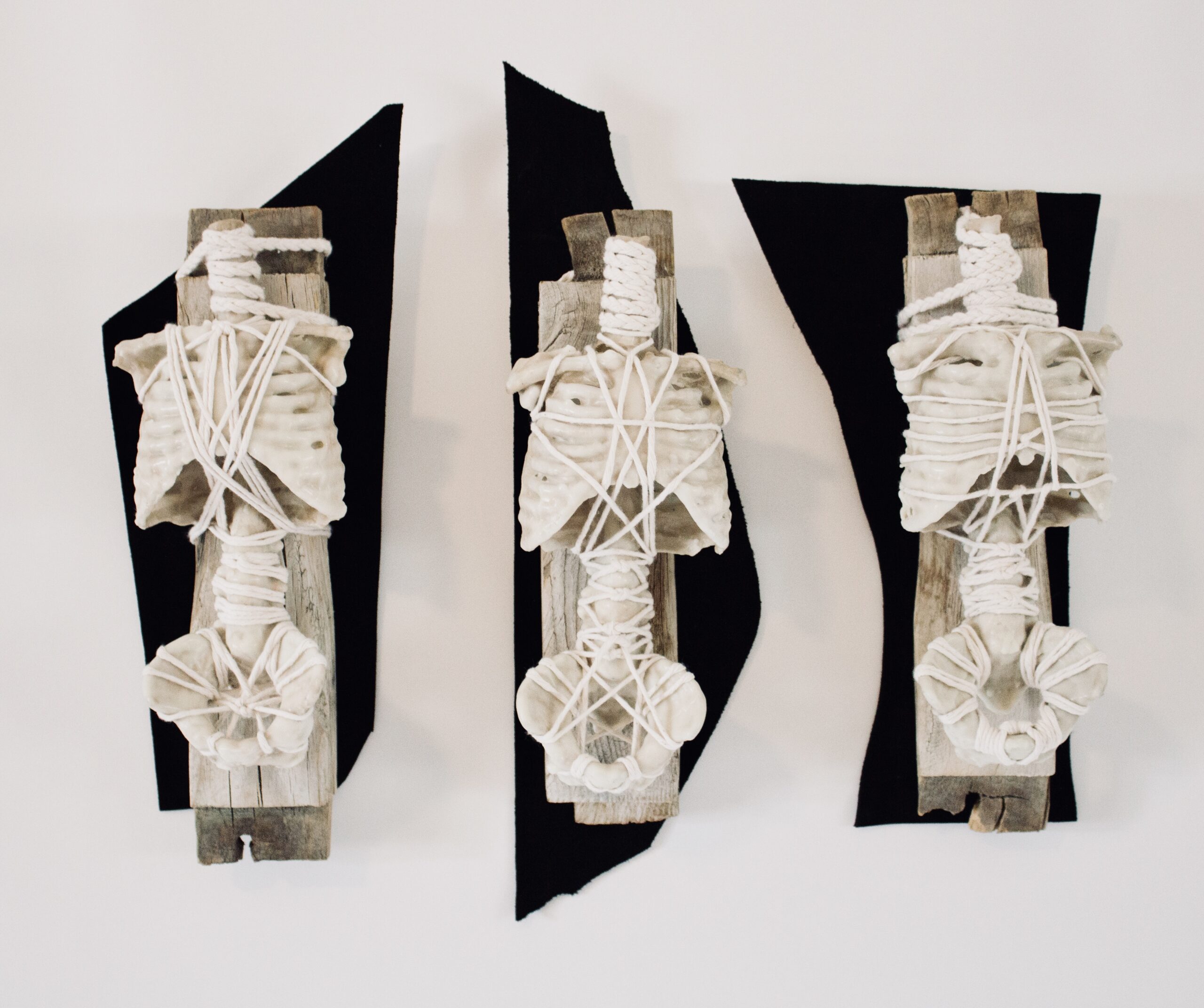
Bones of No Color, 2015-2017
Handmade paper, wood, plastic, encaustic, string, black suede
Left: 16″ X 6″ x 5″
Center: 17″ x 5″ x 5″
Right: 13″ x 7″ x 5″
Photo: Courtesy of Artist
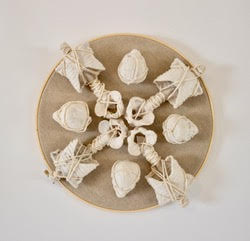
What You Are, We Were / What We Are, You Shall Be, 2015-2017
Handmade paper, plastic, encaustic, linen, wood, string
14″ diameter
Photo: Courtesy of Artist
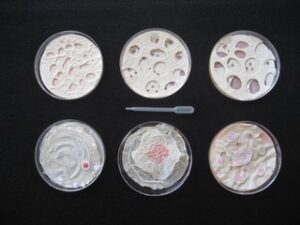
Family Tree or Tree of Life, 2015 – 2017
Petri dishes with transparent handmade paper, thread
Overall: 16″ x 10” x 1”
Photo: Courtesy of Artist
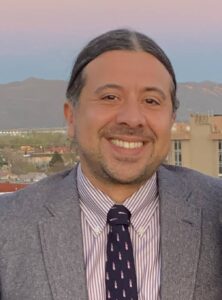
Mark Steel Wool Salinas is an independent art consultant in Reno, Nevada. He serves as a board member for the Pioneer Center for the Performing Arts, Nevada Arts Council, and Americans for the Arts Public Art Network. He is the former founding Director of the Carson City Department of Arts & Culture. Salinas provides public art consulting, creative content, and program management for clients including Smart Growth America, Forecast Public Art, the Town of Truckee, and the Reno-Tahoe International Airport. Along with First Lady Kathy Sisolak and the Nevada State Museum, he established ‘The First Lady presents…’ and serves as art curator.